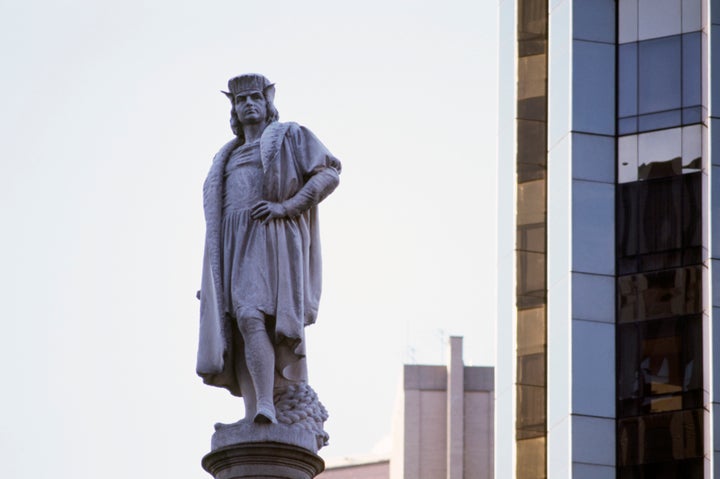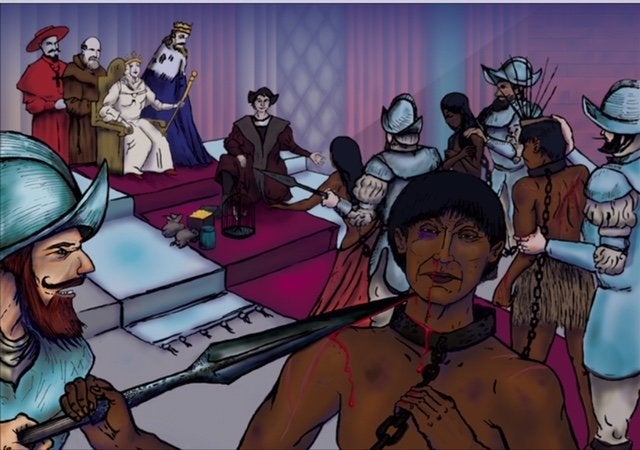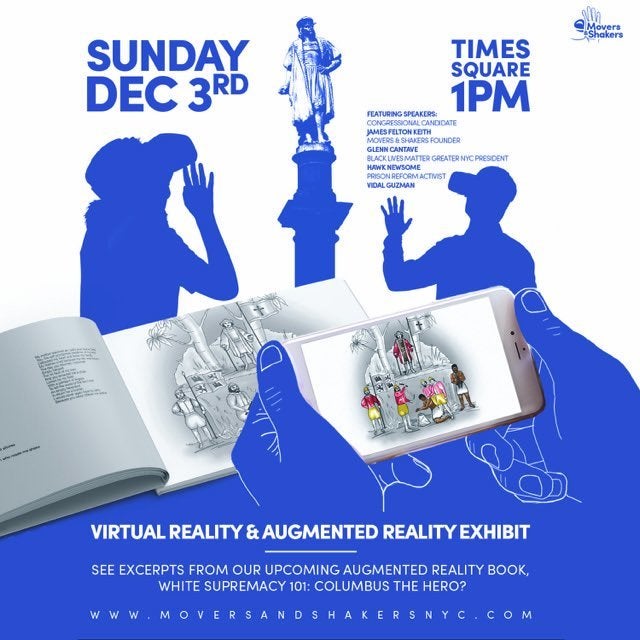In 2013, when Glenn Cantave was an undergrad student studying abroad in Bolivia, he did as many tourists do in the country and visited the colossal statue of Cristo de la Concordia, one of the largest depictions of Jesus in the world.
For many Bolivians, the statue is a site of national pride. The 133-foot figure towers over visitors clamoring to take his photo, his arms outstretched as if offering a giant hug. But for Cantave, something about it felt wrong. “I have nothing bad to say about Jesus as a guy,” he told HuffPost. “But Bolivia has one of the largest indigenous cultures in South America and the religion of Christianity was imposed on its people. This image of a white man looking down on everyone was very problematic.”
The experience shifted Cantave’s perspective on the relationship between men perched on pedestals and the communities obliged to literally look up to them every day. But the monument that angers him most, however, is the one at home: a 76-foot statue of Christopher Columbus, a man who Cantave unequivocally calls a terrorist, in Manhattan.
“A terrorist is someone who intimidates people for a political cause,” Cantave said. “For him, that cause was the expansion of the Spanish Empire for profit. Columbus threatened and raped and murdered. It is ass backwards that a city like New York, with such a high awareness of terrorism, has a terrorist as a landmark.”

I met Cantave at Queens Borough Hall, at the first of five public hearings addressing what should become of New York City’s contentious monuments. Cantave attended and testified at four of the hearings.
Concern over what should become of the controversial monuments ― which Mayor Bill de Blasio referred to as “symbols of hate” ― bubbled over in August when a white supremacist rally protesting the removal of a Confederate statue in Charlottesville, Virginia, turned violent, resulting in the murder of counterprotester and anti-racist activist Heather Heyer. Shortly thereafter, protests erupted in New York demanding the removal of a statue of Dr. J. Marion Sims. Though he is known as the “father of gynecology,” he has a legacy of torturing enslaved women, performing “experimental surgeries” on them without anesthesia.
In early September, de Blasio announced that he was forming a committee, called the Mayoral Advisory Commission on City Art, Monuments and Markers, to advise him on what should become of the various controversial monuments strewn throughout the five boroughs.
The commission ― co-chaired by Darren Walker, the president of the Ford Foundation, and Tom Finkelpearl, commissioner of NYC’s department of cultural affairs ― includes artists, architects, professors, activists and scholars of a cross-section of ages, races and genders. Together, they invited interested citizens of various neighborhoods to take the floor of public hearings and share their opinions on the fates of monuments in question, such as statues of Christopher Columbus, Theodore Roosevelt and J. Marion Sims.
In Queens, Cantave addressed a moderate crowd, many of whom were protective of the Columbus statue. Panelists spoke of its historical significance and value to some Italian immigrants. “What this says to me is that my life as a black man does not matter,” Cantave told the room. “My last name is Cantave, it’s a slave owner’s last name. I don’t know my real last name because of Columbus.”

Cantave is the founder and CEO of Movers and Shakers, an activist coalition that uses innovative techniques like virtual and augmented reality to advocate for marginalized and oppressed populations. The organization is currently advocating for the removal of the statues that honor these men.
Over 120 artists and scholars from around the country published an open letter on Friday with similar demands, requesting the removal of Columbus, Roosevelt and Sims monuments along with statues of Vichy France’s Nazi collaborators Philippe Pétain and Pierre Laval.
The letter reads in part:
“By far the most controversial of the monuments is that to Christopher Columbus, who served the Spanish crown, and spoke and wrote only in Catalan. Because he was born in Genoa in 1451 – a city that did not become “Italy” until the unification of the country in 1861 – he was adopted as a patriotic symbol by Italian immigrants in the nineteenth century. But the public claim of “ownership” of Columbus by Italian-Americans cannot be allowed to override his key role in the historical genocide of Indigenous peoples of the Americas. By 1600, at least 50 million Indigenous people died in this hemisphere as a result of the Columbian encounter with Europeans, whether from war, disease or enslavement. It takes only a little understanding to see why their descendants do not regard anything associated with 1492 as an object of veneration.”
Cantave doesn’t just want to remove the monument to Columbus, though. Instead, he suggests replacing the statue with a tribute to Toussaint L’Ouverture, who led the Haitian Revolution in the 18th century. New York has the second highest Haitian population of any U.S. state. Yet L’Ouverture’s significance, Cantave believes, extends beyond the scope of the Haitian diaspora.
“In general, monuments reflect financial glory,” he said. “Oppressed peoples don’t have role models to look up to. L’Ouverture’s efforts resulted in the establishment of the first, free black republic. If you had him glorified as a statue and his name in the textbooks, that would change everything.”
Cantave believes that manifestations of white supremacy today ― in alt-right chatrooms and at pro-Donald Trump rallies ― stem from the same colonizing mindset Columbus brought to America. “Why is the erasure of black and brown history a recurring theme?” he asked.
Earlier this month, he demonstrated the parallels by staging the “Slave Auction 2017” performance in Herald Square, forcing New Yorkers to confront the consequences of Columbus’ historical exploits head on. Protesters formed a procession in the middle of Manhattan, some wearing shackles and others prison uniforms and handcuffs.
“Columbus entered the Americas with the intent of enslaving its inhabitants for the economic benefit of the Spanish crown,” the project description explains. Genocide expert David Stannard estimates that Columbus and Europeans under his leadership killed between 70 million and 100 million indigenous people beginning in 1492. Between 1500 and 1866, approximately 12.5 million people were kidnapped from Africa and enslaved in America. “It was only after his men realized that their slaves were not resistant to European diseases did they decide to use forced labor from West Africa,” Cantave said.
Cantave will continue mounting protests against Columbus’ monument until a decision has been made regarding its future. He’s also working on a Columbus picture book, White Supremacy 101: Columbus the Hero?, that uses augmented reality to amend the falsehoods embedded in the whitewashed history that is often recounted in schools. Working with a team of illustrators, animators, poets, rappers and historians, Cantave transformed black-and-white drawings into animated narratives that come alive with the help of an iPhone. Each page of the book features a five- to seven-second animation loop generated from academically verified accounts of Columbus’ actions.


His live action protests, including a public presentation of “Slave Auction 2017” and an upcoming event on Dec. 3 in Times Square, involve animated excerpts from his upcoming augmented reality book, blown up as 24-by-36-inch prints.
With the book, Cantave hopes to appeal to a scope of readers beyond historians and academics. “A lot of people do not care about Christoper Columbus,” he said. “He’s engrained in our society, but people don’t know what he did. There are people out there who have done the work and told the truth, but if you’re not an academic or a university student, chances are you’re never going to pick up one of their books. We made a talking book. It’s not going to take you more than five minutes to get through.”
Cantave plans to raise funds to produce and distribute the book through Kickstarter.
Ideally, the picture book will reach people the public hearings didn’t ― namely, younger, working class New Yorkers unable to attend an event on a weekday at 10 a.m. This, Cantave speculates, is partially why the majority of the public hearings’ attendees were older, white and predominately in favor of protecting the monuments. “That skewed the distribution of opinions present,” Cantave said.
“Who was my age who was there?” Cantave asked. “It was mostly white senior citizens with conservative opinions,” he added, noting that the only other people in attendance were either engaged in monument work full time or journalists. “The symbols of hate disproportionately affect communities of color and they were not accurately represented. This was supposed to be a display of New Yorkers’ opinions, but it wasn’t.”
Most who testified during the five hearings spoke in defense of Columbus’ statue, if not the man himself. As Queens resident Virginia Caputo put it, “We should not live in a vacuum and judge our statues by our values and standards of today. We are a tolerant and progressive city, humanity had a long and complicated struggle to achieve where we are today.”
“Rome, the ultimate Catholic city, could take down the Colosseum, a symbol of hate where so many early Christians were brutally treated,” she added. “America, New York City is who we are today because of that long road. Don’t erase that.”
Cantave rejects, however, the notion that New Yorkers are solely viewing Columbus from a 21st century lens. “The Spanish empire who put Columbus in power decided he was too cruel as the governor of Hispaniola and put him in jail. This is a matter of objective morality. It transcends centuries,” he said.
And as for tearing down cultural relics, Cantave categorically believes that statues glorifying oppressors don’t deserve to be saved.
“I’m all for destroying a culture that is governed by white supremacy,” he said. “Black and brown people have been uncomfortable for centuries. The culture needs to shift. Everyone knows who Adolf Hitler is so you don’t see any monuments of him in New York. Let’s be on the right side of history.”


